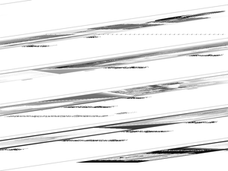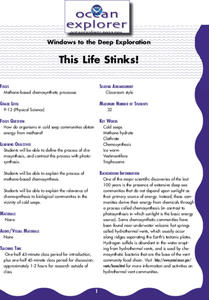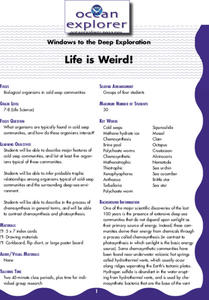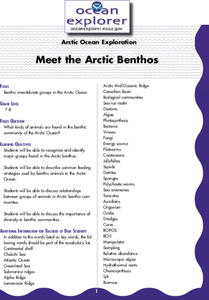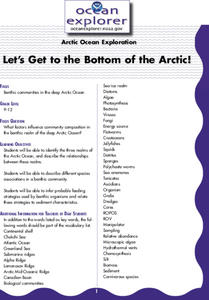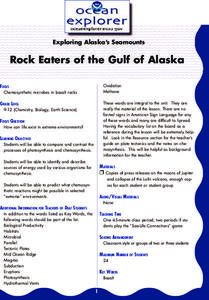Curated OER
Some Like It Hot, Some Like It Cold
Students are explained that thermophiles are organisms that have optimal growth temperatures above 50oC. They investigate the temperature ranges for the growth of common bacteria. Students answer the question of do either of these...
Curated OER
Extremophiles- Non-Fiction Reading Comprehension
In this extremophiles non-fiction reading learning exercise, students read a two page selection that describes the organisms known as extremophiles. They answer 10 questions based on the selection which include true or false, short...
Curated OER
Biochemistry Detectives
Students explore the process of chemosynthesis and relate it to the biological communities in cold seeps. In this biochemistry lesson students interpret analyses of enzyme activity and draw inferences about organisms in cold seep...
Curated OER
Let's Make a Tubeworm!
Students discuss deep-sea chemosynthetic communities then create a poster of a three-dimensional tubeworm. In this creative lesson students create their own tubeworm and write a written report on it.
Curated OER
Ocean World - Interactive On-line Quiz - Coral Reefs
In this coral worksheet, students answer 9 multiple choice questions about coral and coral reefs using an interactive on-line format.
Curated OER
Discovery Science Center Activities
Fourth graders complete a variety of experiments to meet science goals. In this life sciences lesson, 4th graders make yogurt, discover the attraction of opposite charges in electricity, learn the effects of glaciers, and explore...
Curated OER
The Chemosynthetic Cafe
Students study photosynthesis and chemosynthesis. In this chemosynthetic instructional activity students explain the processes of these and define terms.
Curated OER
Entering the Twilight Zone
Students describe major features of cold seep communities and list organisms that are found in these communities. For this water habitat lesson students examine trophic levels, describe the process of chemosynthesis and list the...
Curated OER
Analogies
In this analogies learning exercise, students complete the analogies about fuel, carbon dioxide, decay, and more. Students complete 10 analogies.
Curated OER
Food Chains and Webs--- "What's for dinner?"
Students study food chains and how the organisms are linked. In this investigative worksheet students answer food chain questions, and fill out several worksheets.
Curated OER
This Life Stinks!
Students explore the process of chemosynthesis and contrast this process with photosynthesis. They consider the relevance of chemosynthesis to biological communities in the vicinity of cold seeps.
Curated OER
Life is Weird!
Students describe major features of cold seep communities, and list at least five organisms typical of these communities. They infer probable trophic relationships among organisms typical of cold-seep communities and the surrounding...
Curated OER
Going to Extremes
Pupils recognize that our ability to explore the extremes of the ocean is directly related to the technology of remote sensing. Students will recognize the deep submergence vehicle, Alvin, and the advanced sensors on board as tools for...
Curated OER
Meet the Arctic Benthos
Students recognize and identify major groups found in the Arctic benthos. They describe common feeding strategies used by benthic animals in the Arctic Ocean. They discuss relationships between
Curated OER
Let's Get to the Bottom of the Arctic!
Pupils identify the three realms of the Arctic Ocean, and describe the relationships between these realms. They describe different species associations in a benthic community.
Curated OER
One Tough Worm
Students explain the process of chemosynthesis. They are able to explain the relevance of chemosynthesis to biological communities in the vicinity of cold seeps.
Curated OER
This Old Tubeworm
Students explain the process and significance of chemosynthesis. They develop their own graphic based on data of a biological community. They estimate the age of a given species as well.
Curated OER
Rock Eaters of the Gulf of Alaska
Students compare and contrast the processes of photosynthesis and chemosynthesis. They identify and describe sources of energy used by various organisms for chemosynthesis.
Curated OER
Science: What Happens to Create the Lode?
High schoolers understand how mineral deposits are formed and why they are not evenly dispersed. They create and describe three different precipitates from four solutions simulating mineral ore deposit formation in sedimentary rock.
Curated OER
Science: Not just Gold
Students articulate a possible relationship between arsenic and gold deposits in a written statement using data to substantiate the relationship they describe. They use real data to determine the source of the arsenic in the drinking...
Other popular searches
- Hydrothermal Vents
- Hydrothermal Vent Chemistry
- Facts for Hydrothermal Vents
- Hydrothermal Fluid
- Hydrothermal Vents Facts
- Hydrothermal Vents Food Web
- Hydrothermal Vent Animals
- Hydrothermal Vents Bacteria
- Facts on Hydrothermal Vents
- Hydrothermal Vent Ecosystem
- Hydrothermal Energy Pyramids
- Hydrothermal Activity








